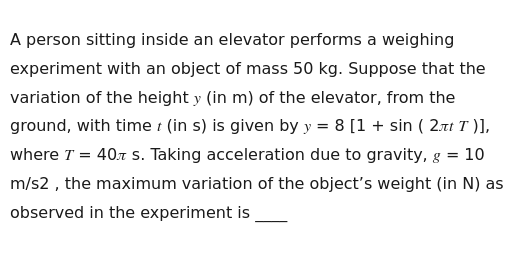Question
Question: A person sitting inside an elevator performs a weighing experiment with an object of mass 50 kg. Sup...
A person sitting inside an elevator performs a weighing experiment with an object of mass 50 kg. Suppose that the variation of the height 𝑦 (in m) of the elevator, from the ground, with time 𝑡 (in s) is given by 𝑦 = 8 [1 + sin ( 2𝜋𝑡 𝑇 )], where 𝑇 = 40𝜋 s. Taking acceleration due to gravity, 𝑔 = 10 m/s2 , the maximum variation of the object’s weight (in N) as observed in the experiment is ____

2
Solution
The height of the elevator from the ground is given by y(t)=8[1+sin(T2πt)], where T=40π s.
We can rewrite the expression for y(t) as y(t)=8+8sin(T2πt).
The velocity of the elevator is the first derivative of y(t) with respect to time:
vy(t)=dtdy=dtd(8+8sin(T2πt))=0+8cos(T2πt)⋅T2π=T16πcos(T2πt).
The acceleration of the elevator is the second derivative of y(t) with respect to time:
ay(t)=dtdvy=dtd(T16πcos(T2πt))=T16π(−sin(T2πt))⋅T2π=−T232π2sin(T2πt).
Substitute the given value T=40π s:
ay(t)=−(40π)232π2sin(40π2πt)=−1600π232π2sin(20t)=−160032sin(20t)=−501sin(20t).
The observed weight of the object in the elevator is the normal force exerted by the weighing machine on the object. According to Newton's second law, the net force on the object is equal to its mass times its acceleration. Taking the upward direction as positive, the forces acting on the object are the normal force N (upwards) and the gravitational force mg (downwards). The net force is N−mg=may, where ay is the acceleration of the elevator in the upward direction.
So, the observed weight is N(t)=mg+may(t).
Given mass m=50 kg and acceleration due to gravity g=10 m/s2.
The true weight of the object is mg=50×10=500 N.
The observed weight is N(t)=500+50ay(t).
Substitute the expression for ay(t):
N(t)=500+50(−501sin(20t))=500−sin(20t).
The observed weight N(t) varies with time. The range of the sine function sin(θ) is [−1,1].
The minimum value of N(t) occurs when sin(20t) is maximum (1):
Nmin=500−1=499 N.
The maximum value of N(t) occurs when sin(20t) is minimum (-1):
Nmax=500−(−1)=500+1=501 N.
The maximum variation of the object's weight is the difference between the maximum and minimum observed weights.
Maximum variation =Nmax−Nmin=501−499=2 N.
